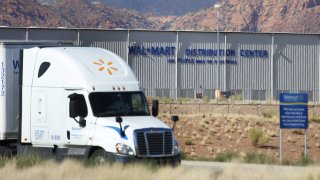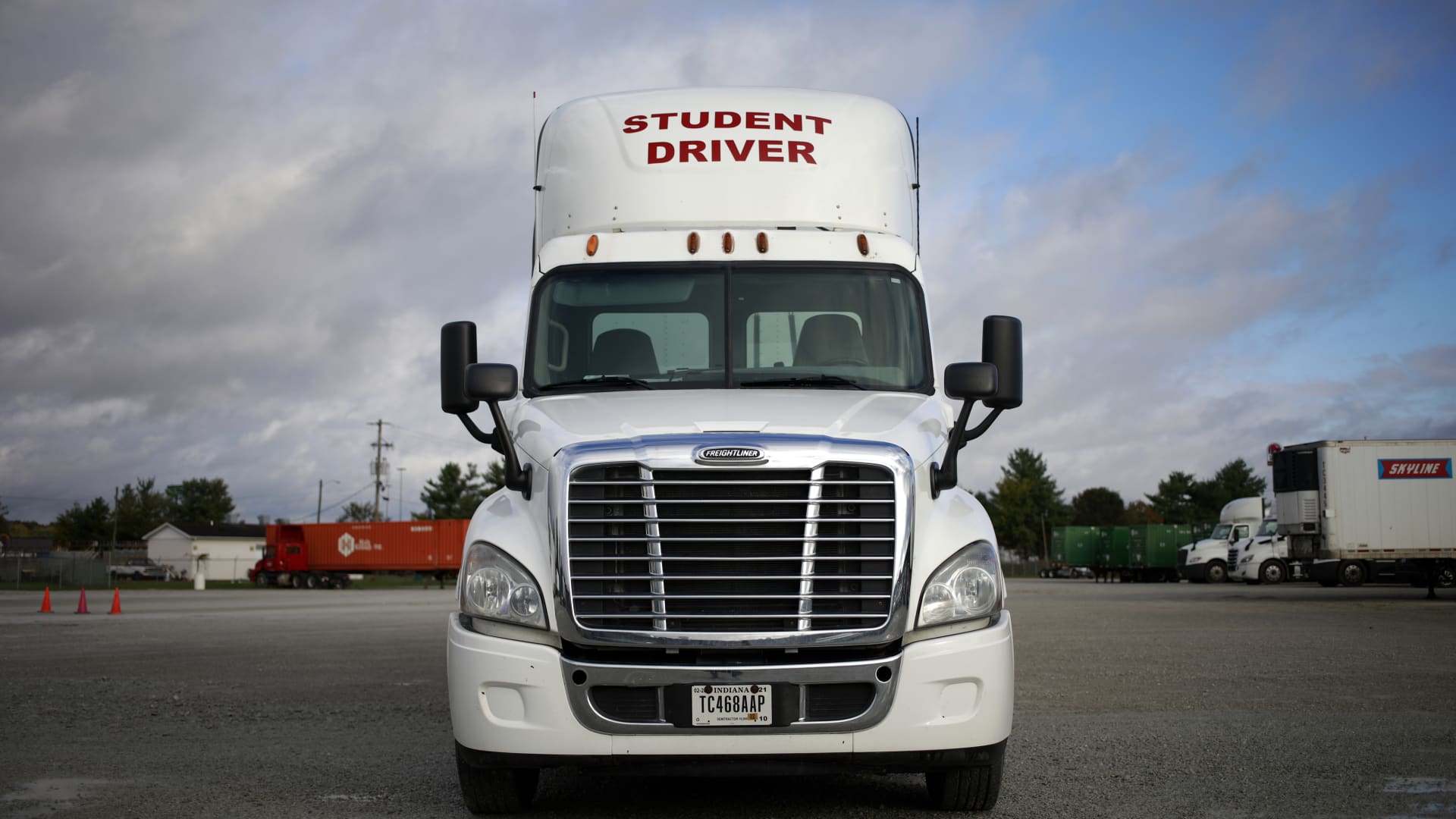
- In April, Walmart made headlines by announcing that it will pay its private fleet truck drivers as much as $110,000 in their first year with the big-box retailer.
- The median pay for big-rig drivers in 2021 was $48,310, or about $23 an hour, according to Bureau of Labor Statistics data.
- Pay is far from the only issue in a long-haul sector that has a shortage of drivers forecast to double to 160,000 by 2030: competition from e-commerce, retirements, and difficulty attracting new workers and female workers are big issues.
In April, Walmart made headlines by announcing that it will pay its private fleet truck drivers as much as $110,000 in their first year with the big-box retailer, up from an average starting salary of $87,000. Yellow Corp., a holding company for several carriers, said its drivers can make up to $100,000 a year. Some trucking companies are offering $10,000 cash bonuses to new drivers.
Meanwhile, the American Trucking Associations (ATA) reported a shortage of 80,000 drivers last year, an all-time high that could reach 160,000 by 2030. The solution, the ATA said, is to recruit a million new drivers over the next decade.
At first glance, this might look like the perfect time to get behind the wheel of a big rig. But when you look under the hood of this time-honored profession — which in 2020 employed more than 1.95 million heavy and tractor-trailer truck drivers, according to the U.S. Bureau of Labor Statistics (BLS) — you discover that not everything is running smoothly.
We're making it easier for you to find stories that matter with our new newsletter — The 4Front. Sign up here and get news that is important for you to your inbox.
"Trucking is a story of bifurcation," said Steve Viscelli, an economic sociologist at the University of Pennsylvania, who has researched the industry for more than 15 years. "There are some excellent jobs and some terrible jobs."
Walmart's more than 12,000 drivers fall into the former category, beneficiaries of the company's nearly 21% salary bump. "Our goal with raising pay was to ensure Walmart remains one of the best driving jobs in the industry," said Fernando Cortes, senior vice president of transportation, in an email. "These recent investments will help us continue to hire aggressively to meet increased demand from customers." Last year, Walmart brought on nearly 4,500 new drivers, the most in company history, Cortes said, and "we aim to hire over 5,000 this year, which includes training between 400 to 800 new drivers through our Private Fleet Development program."
Median pay for big-rig drivers under $50,000
Money Report
Putting Walmart aside, the median annual pay for big-rig drivers in 2021, per BLS, was $48,310 or about $23 an hour. Many of them work 60-70 hours a week, though a good deal of that time is spent waiting for goods to be loaded or unloaded, and they're only paid for driving time. Many aren't compensated for overtime, don't have health care benefits, are paying their own fuel costs and spend days or weeks away from home.
Those are among the reasons why numerous industry insiders contend that it's not so much a matter of a driver shortage, but rather an issue of retaining drivers in less-than-desirable jobs.
At the large truckload carriers, such as J.B. Hunt Transport Services, Swift Transportation and Werner Enterprises, which haul a single commodity that fills an entire trailer, annual turnover rates averaged 94% between 1995 and 2017, according to a BLS report. Conversely, among major less-than-truckload (LTL) carriers, including Yellow, UPS and XPO Logistics, whose trailers carry multiple items for numerous customers, the turnover rate was less than 12%.
Addressing the driver shortage, ATA chief economist Bob Costello pointed to several contributing factors. "Part of the shortage is drivers leaving the industry because they are retiring," he said in an email, noting that the average age of drivers is mid to late 40s. "Some people do get into the industry and realize that the lifestyle is not for them," Costello added, "but I don't know what percentage that is. There are job alternatives that have them home every night, like delivering packages for e-commerce [businesses]."
The ATA also cited the low number of women drivers, only 7%; drivers failing drug tests, especially in states where recreational marijuana is legal; federal laws requiring interstate drivers to be at least 21; and applicants for a commercial driver's license (CDL) declined for poor driving records or criminal backgrounds.
"We've listened to this driver shortage nonsense since the 1980s," said Todd Spencer, president of the Owner-Operator Independent Drivers Association (OOIDA), which represents roughly 150,000 members who own and/or operate more than 240,000 individual heavy-duty trucks and small truck fleets. "If you have a business where [more than 90%] of your workforce turned over every year, how efficient or good a business would it be? Yet it's commonplace in trucking, because they can't keep workers. I don't know how you classify that as a shortage."
As distinct as these two labor markets are, they're linked to one another. "The big truckload firms with high turnover rates have the greatest interest in recruiting and training new drivers," said Viscelli, who worked undercover at a driver-training school, drove a long-haul truck for six months and subsequently wrote The Big Rig: Trucking and the Decline of the American Dream. "They are the central entrance to the pipeline. The better employers have sat back, let those crappy companies recruit, train and employ drivers for a year or two, then skim the cream off the top."
In the worst-case scenarios, a truckload carrier will cover the cost of training new recruits to obtain a CDL — private driving schools charge up to $10,000 — then hire them, at low minimum wages or per-mile rates, as independent contractors who have to pay all their own expenses. Some companies lock new drivers into exclusive contracts, for two years or longer, and if they quit during the interim, bill them to recoup the training costs.
The ATA, with affiliates in all 50 states, represents the wide spectrum of trucking companies, from publicly owned truckload carriers that transport goods coast-to-coast to local delivery services that drop off packages to homes and businesses. The association's latest trends report stated that as of February 2021, the Department of Transportation's Federal Motor Carrier Safety Administration had 996,894 for-hire carriers on file, along with an additional 813,440 private fleets. The vast majority of those are small owner-operator businesses, with 97.4% running fewer than 20 trucks and 91.5% with six trucks or less.
Of the nearly 38 million trucks registered for commercial use in the U.S. in 2020, 3.91 million were Class 8 vehicles, typically tractor-trailers weighing over 33,000 pounds. According to the U.S. Census Bureau's Commodity Flow Survey, trucks transported 71.6% or $10.4 trillion of the $14.5 trillion of the value of all goods shipped in 2017, the latest year for which statistics are available.
These are not the truck drivers glamorized in 1970s movies like Smokey and the Bandit, Every Which Way But Loose and Convoy. The industry was deregulated in 1980 when President Jimmy Carter signed the Motor Carrier Act. Before then, there were fewer than 20,000 authorized interstate trucking companies in the country, and the majority of big-rig drivers were members of the Teamsters union, earning an average of more than $100,000 in today's dollars. Deregulation opened the floodgates to fierce competition among shippers and carriers, as well as drivers. Today more than 10 million Americans hold a CDL, Viscelli said, nearly triple the 3.5 million jobs that require the certification.
Only about 60,000 of those CDL holders are members of the Teamsters, said Danny Avelyn, director of the union's freight division. "Our drivers work for the LTL carriers, and they're extremely busy," he said. "There are plenty of people interested in driving jobs, but it's about working where the pay and benefits are the best." The average annual earnings of Teamsters who drive for major carriers is $80,000, plus health care, overtime and other perks, "and the majority of our people go home at night," Avelyn said.
In December, in response to persistent supply chains disruptions and rising inflation, the U.S. Department of Transportation (DOT) and the U.S. Department of Labor (DOL) announced the Biden-Harris Trucking Action Plan. The initiative features a federally funded apprenticeship program for truckers, involving more than 100 employers and industry partners. "Making sure truck drivers are paid and treated fairly is the right thing to do, and it will help with both recruiting new drivers and keeping experienced drivers on the job," said Transportation Secretary Pete Buttigieg.
Yellow is coordinating with the DOL in running its 20 driving academies across the country. "Our academies are paid, one-year apprenticeship programs that consist of four weeks of classroom instruction and on-the-road training with a certified instructor," said Tamara Jalving, the company's vice president of safety and talent acquisition. The students, hired as Yellow employees at $17.50 an hour, earn a CDL and then receive an additional four weeks of skills training. "They all become Teamsters," Jalving said, "and can make between $65,000 and $95,000 a year, but the company has a good number of drivers who make more than $100,000," plus full family benefits and hourly pay for load delays and layovers.
The Yellow academies, which receive state and federal grant support, graduated 650 drivers in 2021 and anticipate 1,000 this year, Jalving said. "It's important that every [carrier] take this approach. We have to stop poaching each other's talent and start efforts in developing new drivers," she said.

Those efforts include attracting, and retaining, more women to the industry, which is a focus of the Women in Trucking Association (WIT). In addition to working with Boys and Girls Clubs and Girls Scouts to raise awareness among young women about the profession, "We have a mentoring program that matches seasoned female drivers with new female CDL holders," said president and CEO Ellen Voie.
Personal safety is the number-one reason women leave trucking, Voie said. A whitepaper recently published by WIT, "Addressing Gender Bias and Harassment in the Trucking Industry," includes results of a survey of women drivers. More than half reported that while on the job they have received verbally offensive comments more than once, 28% have received multiple verbal threats, 39% have been subject to an unwanted physical advance more than once, and nearly 4% have experienced rape.
Another issue leading drivers to quit their jobs are unscrupulous lease-purchase agreements. In general, under a lease-purchase deal, a carrier leases a truck to a driver, who assumes responsibility for regular payments and sometimes fuel costs, maintenance and other overhead. Ideally, once the full cost of the lease is paid, the driver owns the truck. There are many instances, however, where drivers can't keep up payments and default on the agreement.
"There is a segment of the industry that make lease-purchase arrangements attractive to drivers who don't have credit," Spencer said. "They may seem attractive at the time, but more often than not, they turn out to be basically unkept promises. When they recognize it's not a good deal, they will say bye," he said, at the risk of personal liability and financial ruin. "That's often predatory, but also blatantly unfair in that you have your personal credit and other assets that get dragged into this."
A provision included in the Bipartisan Infrastructure Law, and reiterated in the White House's Trucking Action Plan, calls for the formation of a truck leasing task force that will investigate predatory truck leasing arrangements with the DOL and the Consumer Financial Protection Bureau.
Looming over the various issues impacting truck drivers is the ongoing development of autonomous trucks by tech companies including Aurora, Waymo, Tesla and TuSimple, as well as legacy truck manufacturers such as Daimler, Volvo and Navistar. A recent academic study found that as many as 500,000 long-haul driver jobs may be impacted.
Proponents of self-driving trucks point to improved safety and greater efficiency versus human drivers, who by law can't drive more than eight hours before taking a break, and no more than 11 hours daily. "Safety is really the founding reason that Waymo started working on this technology," said Charlie Jatt, the startup's head of commercialization for trucking, at a recent industry conference.
The Teamsters, predictably, are not in favor of autonomous trucks, "not even a little bit," Avelyn said, who questions the safety argument. "I don't think the motoring public is ready for an 80,000-pound, unmanned tractor-trailer going down the interstate. I'm not," he said. The OOIDA has issued a paper stating, "The vast majority of OOIDA members are against autonomous truck technology for a variety of different reasons, including safety, job security and cost, both for the technology itself and for infrastructure."
Avery Vise, vice president of trucking for FTR Transportation Intelligence, said that autonomous trucks are on the horizon, "but we're not talking about them having a significant amount of freight hauling until the second half of the next decade or later." The best applications, he said, will be long, flat stretches along interstates, as opposed to short-haul deliveries in urban areas, where drivers will still be needed.
"I don't think [self-driving trucks] reduce the number of drivers you need," Vise said. "They just change the nature of the driver job, making it a local job where you're home at night, which is where the industry wants to be anyway. If you want to drive a truck, you'll always have a job."






